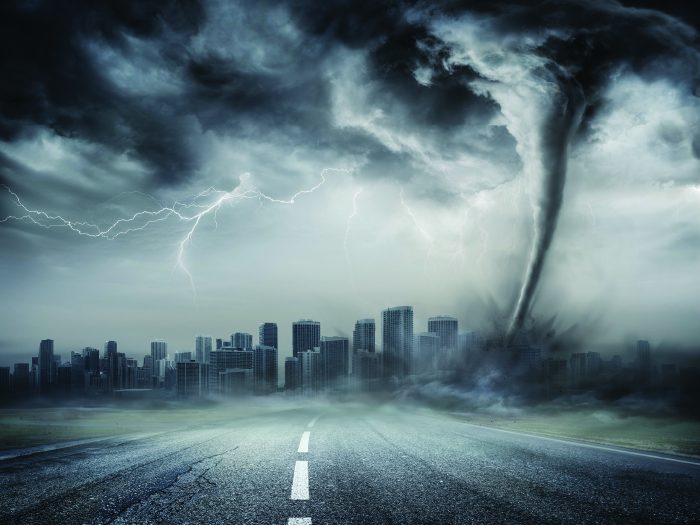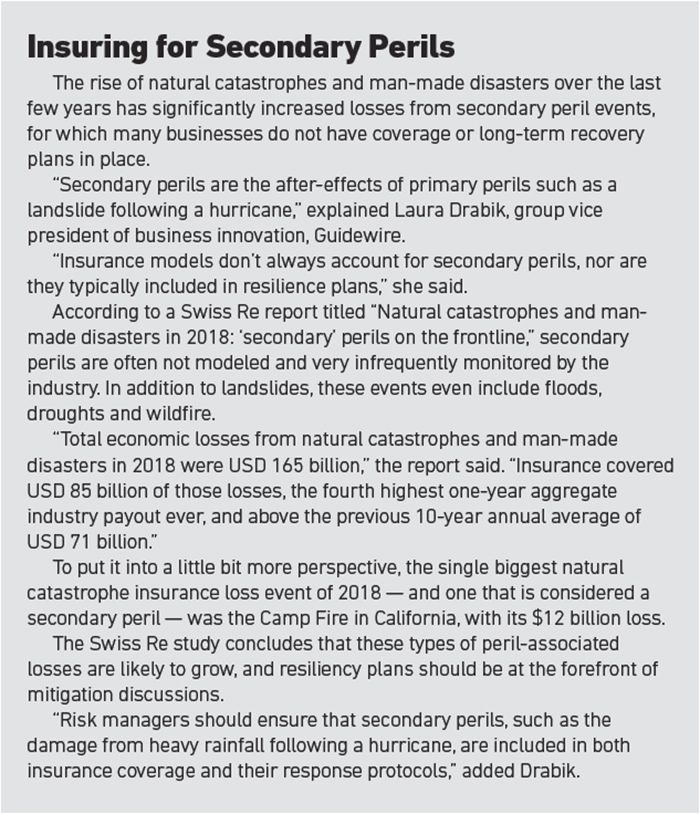Uninsured Losses Continue to Rise from Nat Cats. These Emerging Resiliency Approaches Can Help

Fires, floods, earthquakes, mudslides and more are damaging businesses for extended periods. In total, insured losses due to natural catastrophes in 2018 were $90 billion — a scary number. Even more terrifying: Total losses were $225 billion.
It doesn’t help, either, that these natural catastrophes are growing in intensity and adding to the gap between insured and uninsured losses.
In 2017, the U.S. experienced 71,499 wildfires. Approximately 10 million acres burned. The California Department of Insurance reported insurance claims from October through December equalling close to $12 billion. It was the costliest fire season on record.
Then 2018’s wildfires happened.
There were fewer fires in total, but a prolonged dry season led to deadlier flames: The Camp Fire, breaking the record for the deadliest and most destructive fire in the state, burned 153,000 acres and 18,800 structures in 2018. Eighty-eight people died. The California Department of Insurance reported another year of insurance claims equaling $12 billion.
And it’s not just wildfires; in the last few years, hurricanes too have battered U.S. shores. The Insurance Information Institute estimated about 70% to 80% of 2018’s Hurricane Florence claims were uninsured.
The Midwest had one of its harshest winters in recent history, where “the coldest temperatures in almost two decades … spread into the northern and central U.S.,” according to the National Weather Service. Residents were advised to stay indoors and refrain from breathing deeply.
Heavy spring rains further led to flooding in this same region, which caused a total of $2.9 billion in property damage.
“The increased number of natural catastrophes in the recent years around the world is the leading driver of CAT losses for insurers,” said Laura Drabik, group vice president of business innovation, Guidewire.
And each catastrophe presents a spectrum of losses: business interruption claims; loss of vital infrastructure; pollutants and other environmental concerns; higher chances of mold and mildew festering in the aftermath; public health concerns and the potential spreading of disease.
(Pools of stagnant water become breeding grounds for mosquitoes — after Hurricane Katrina, a doubling of West Nile disease cases was seen in the hurricane-affected areas of Louisiana and Mississippi, Forbes reported.)
Insurers and insureds alike are developing and embracing ways to mitigate the impact a storm may continue to have long after it has passed.
Here’s where engineering, resilience and business continuity planning come in; and their importance is growing more pressing every year.
Reviewing Traditional Means
“Traditionally, insureds have focused their resiliency on insurance coverage, making sure that their business and their infrastructure are insured,” said Drabik.
But, she added, “while traditional methods are effective in helping manage the immediate impact of catastrophes, often forgotten is the long-term impact of these events.”

Laura Drabik, group vice president of business innovation, Guidewire
Business interruption, for example, is a big one: Business Continuity Institute’s Business Continuity and Resilience Report 2018 found that the average cost of a severe business interruption was $350,000 last year.
Companies surveyed for the report responded that extreme weather is contributing to expanding BI over the long term, ranking it the fourth biggest threat in the next 12 months.
Ken Katz, national property risk control director at Travelers, told Risk & Insurance® last month that “the cascading impacts of some risks are still often misunderstood. People know a hurricane causes wind and flood damage, but there is less thought about the effect on telecoms or the inability of people to get to places in the aftermath, which also can affect businesses.”
For risk managers, who are also traditionally trained in the proper protocols and procedures following a catastrophic event, a bigger emphasis is needed on planning for business interruption, Drabik said.
“These costs are even greater following a catastrophe,” she explained.
“This is a result of companies relying heavily on technology that may have gone down due to falling power lines, internet and other outages as a result of the catastrophe.”
Puerto Rico, for example, which was devastated by 2017’s Hurricane Maria, is still working to build itself back up to where it was before the storm hit — nearly two years later.
So what tools are at insureds’ fingertips to better manage CAT risks? What methods are in place for long-term resilience?

Working in Real-Time With Risk Managers
Keeping infrastructure intact during an event is a surefire way to keep a business running. But that’s not the only means to keep things going.
“In the past, because of flooding, wind damage, etc., we’ve seen companies left at a standstill,” said Jonathan Salter, head of global property risk engineering, AXA XL Risk Consulting.
“Having contingency plans in place gives companies considerable flexibility and resilience. After some of the storms that we’ve seen, this means plenty to the company itself, but it also means a lot to its employees and its community, and everyone’s overall ability to make a quick recovery.”
As part of its own efforts to help, AXA XL Risk Consulting built SiteForward, a platform that offers a suite of risk management capabilities and tools to its clients. It’s one way Salter and his team are keeping businesses prepared.
SiteForward enables risk managers to see changes occurring during natural catastrophes, anywhere in the world, in real-time.
“Keeping this kind of collective surveillance on all of their facilities allows [clients] to act quickly and deploy necessary resources to reinforce property protection — that may mean moving supplies in storage to higher ground if there is a danger of flooding; or clearing bush and debris if they see themselves in the path of a wildfire,” explained Salter.
Preparing for today’s severe storms is a process of continuous improvement. That means working to help track any actionable loss prevention tactic available.
“A proper combination of infrastructural resilience, business protocols and insurance coverage are needed to help companies avoid long-term effects of catastrophes.” — Laura Drabik, group vice president of business innovation, Guidewire
“Also, being able to run reports that summarize these strategies, the cost of implementation and the cost of incurred and/or potential losses, allows risk managers to clearly communicate with senior leadership,” he said.
“This can be very helpful in mobilizing support for loss prevention strategies that are designed to keep business operational after NAT CAT events.”
Technology and Resiliency
SiteForward is just one new contingency planning tool; technology like this is playing a huge role in resiliency efforts and advancements as well.
“Thanks to enhanced imaging, more accessible field evaluations and improved data models, CAT preparedness has become more accurate, helping ensure businesses are prepared,” said Drabik.
“Also, with technology playing a critical role in disaster response, insurers are able to focus more on their role in helping prepare for future catastrophes.”
Drones and digital imaging are two big technologies helping insurers advance in their event preparedness. Both before and after a storm rolls through, these technologies help insurers and risk managers better assess risks from the ground and in seconds.
Some additional tools:
- WeGoLook — an on-demand field service provider that can provide both access to fleets and “lookers” who are readily available to capture data and assess risks;
- Livegenic — a real-time video solutions company that provides immediate imaging and assessment of damage to insurers;
- Chatbots — which enable quick communication between insurers and risk managers following a catastrophe;
- Kespry — a drone-based system that claims adjusters can use to safely inspect a roof to appraise a property safely from the ground using a screen, like an iPad; and
- Aerial and satellite imaging — where both insurers and risk managers can gain access to off-limit areas.
“Like many areas of business, having more data available and organized in such a way that we can make wise, information-based decisions is helping advance resiliency and business continuity strategies before and after CAT events,” added Salter.
Always Prepared
To put it simply — long-term planning supports long-term resilience, Salter said.
“It’s important that all interested parties, including risk managers, insurers and Insurtechs, collaborate as efficiently as possible on solutions,” added Drabik.
“Each group has a different perspective on what’s needed and what’s possible, and through collaboration they can account for each other’s blind spots to help address catastrophes quicker and prevent further damage in the future.
“A proper combination of infrastructural resilience, business protocols and insurance coverage are needed to help companies avoid long-term effects of catastrophes,” she said.
“There is no such thing as being ‘too’ protected.” &










